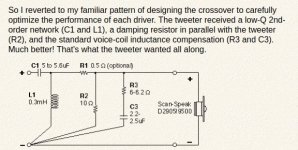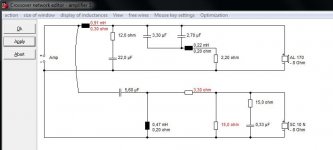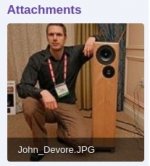A notch filter is an LCR network applied to the 4.8kHz bass breakup peak. The Madisound design looks much simpler than the Troels Gravesen one.
https://www.madisound.com/library/w18e-001-r2904-7000-passive-crossover-design/
Here, 6uF, 0.22mH and 2R. Should be about right.
I would go with the madisound one initially, since it is simpler. Now you just need to allow for your 4.7R 90dB 2905/9300 tweeter as opposed the 94dB R2904-7000.
Less attenuation in the tweeter filter. The cabinet is somewhere around 20-25L reflex. Troels has some details.
.
https://www.madisound.com/library/w18e-001-r2904-7000-passive-crossover-design/
Here, 6uF, 0.22mH and 2R. Should be about right.
I would go with the madisound one initially, since it is simpler. Now you just need to allow for your 4.7R 90dB 2905/9300 tweeter as opposed the 94dB R2904-7000.
Less attenuation in the tweeter filter. The cabinet is somewhere around 20-25L reflex. Troels has some details.
.
Maybe i can use madisounds crossover design for Seas W18e001.A notch filter is an LCR network applied to the 4.8kHz bass breakup peak. The Madisound design looks much simpler than the Troels Gravesen one.
https://www.madisound.com/library/w18e-001-r2904-7000-passive-crossover-design/
Here, 6uF, 0.22mH and 2R. Should be about right.
I would go with the madisound one initially, since it is simpler. Now you just need to allow for your 4.7R 90dB 2905/9300 tweeter as opposed the 94dB R2904-7000.
Less attenuation in the tweeter filter. The cabinet is somewhere around 20-25L reflex. Troels has some details.
.
But how shall I design for Scanspeak 2905/930000?
I just told you. The tweeter level needs adjustment in the Madisound design.
http://www.nutshellhifi.com/Arieltxt2.html
I don't suppose the 9500 is wildly different from the 9300 tweeter.
So you use the bass section from Madisound and adjust the tweeter resistors along these lines.
http://www.nutshellhifi.com/Arieltxt2.html
I don't suppose the 9500 is wildly different from the 9300 tweeter.
So you use the bass section from Madisound and adjust the tweeter resistors along these lines.
Attachments
I just ran your proposed W18E001 plus Scanspeak 2905/9300 speaker up the simulator flagpole.
Looks promising!
Crossover and Cabinet looks easy enough. No idea if it will sound any good, but technically OK. Bit bass light IMO, but we can fix that with a bigger (Say 1.2mH bass coil).
The 3.3R can be changed to 1R for more tweeter loudness.
I always like to try new ideas out. How's about an offset tweeter and inverted drivers? Very John DeVore. One of my heroes. Mirror image pairs, of course.
Looks promising!
Crossover and Cabinet looks easy enough. No idea if it will sound any good, but technically OK. Bit bass light IMO, but we can fix that with a bigger (Say 1.2mH bass coil).
The 3.3R can be changed to 1R for more tweeter loudness.
I always like to try new ideas out. How's about an offset tweeter and inverted drivers? Very John DeVore. One of my heroes. Mirror image pairs, of course.
Attachments
Please give me the crossover. It will help a lot. How big is the box?I have built a TM using W18E001 and T25CF002. Crossover at 2,2 KHz and breakup is way down in level.
Regards/Leif
I wonder if a serial filter will be more easily to do with this drivers?I have built a TM using W18E001 and T25CF002. Crossover at 2,2 KHz and breakup is way down in level.
I doubt it. Serial filters rely on mechanically well-behaved drivers and impedance correction.
Your SEAS metal driver hardly qualifies, does it?
https://www.diyaudio.com/community/threads/flat-impedance-and-flat-power-response-design.302001/
Your SEAS metal driver hardly qualifies, does it?
https://www.diyaudio.com/community/threads/flat-impedance-and-flat-power-response-design.302001/
No I dont think so.I doubt it. Serial filters rely on mechanically well-behaved drivers and impedance correction.
Your SEAS metal driver hardly qualifies, does it?
https://www.diyaudio.com/community/threads/flat-impedance-and-flat-power-response-design.302001/
Seas w18e, 4800hz rising is not good.
So I cant use a notch filter when using serial crossover?
If anyone in the Universe can design a serial or series crossover for your SEAS W18 woofer, it's probably me. 😎
Frankly I don't have the time. For one thing it might take a stepped baffle.
No, either go with my previous suggestion or follow Mr. Troels Gravesen.
http://www.troelsgravesen.dk/TJL_2W.htm
Frankly I don't have the time. For one thing it might take a stepped baffle.
No, either go with my previous suggestion or follow Mr. Troels Gravesen.
http://www.troelsgravesen.dk/TJL_2W.htm
I suppose that Troels is better. It have better phase between drivers.If anyone in the Universe can design a serial or series crossover for your SEAS W18 woofer, it's probably me. 😎
Frankly I don't have the time. For one thing it might take a stepped baffle.
No, either go with my previous suggestion or follow Mr. Troels Gravesen.
http://www.troelsgravesen.dk/TJL_2W.htm
Last edited:
Leif,
I have been using a W18E based speaker for the past 20 years now. I started out with a DIY speaker known as the 1801, designed by Dave Ellis. I moved on to a 2 1/2 way design with two W18E drivers after my intial 1801 construction in 2002. David Ellis still has a website, http://www.ellisaudio.com/ and can be contacted thru the link there. He does occasional post here on the forum, but not often. David is quite well versed in the W18E driver and how to design a 2 way speaker with it.
Other than that, the Troels 2 way design would be the way to go.
Steve
I have been using a W18E based speaker for the past 20 years now. I started out with a DIY speaker known as the 1801, designed by Dave Ellis. I moved on to a 2 1/2 way design with two W18E drivers after my intial 1801 construction in 2002. David Ellis still has a website, http://www.ellisaudio.com/ and can be contacted thru the link there. He does occasional post here on the forum, but not often. David is quite well versed in the W18E driver and how to design a 2 way speaker with it.
Other than that, the Troels 2 way design would be the way to go.
Steve
System7 or anyone with appropriate software… please see if you can work up an 1800hz 4th order acoustic for the W18e001…I am wondering if a 2.5mH inductor with the Madisound notch filter discussed above might do the trick.
There was another design Pegasus, by North Creek audio. I still have the enclosure plans, can post if someone interesting.
I remember a description of the crossover: it’s was low Q, but not high order, or steep notch. Fc was about 1/2 of that magnesium resonance peak.
I remember a description of the crossover: it’s was low Q, but not high order, or steep notch. Fc was about 1/2 of that magnesium resonance peak.
If I remember correctly he used a 1600hz 3rd order design..not sure if there was a notch after that. I guess I am just trying to Thor light…ie do an MT trying a larger primary inductor followed by a notch filter.
- Home
- Loudspeakers
- Multi-Way
- Seas W18e001


